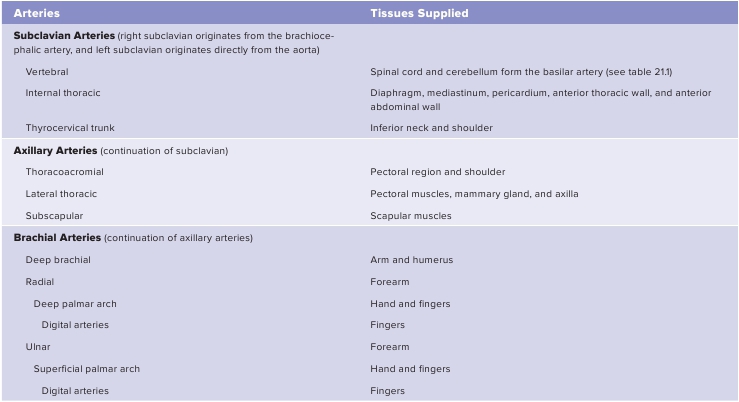732
PART 4 Regulation and Maintenance
TABLE 21.2
Arteries of the Upper Limb (figures 21.13 and 21.14)


ASSESS
YOUR PROGRESS
18.
Name the parts of the aorta.
19.
Name the arteries that branch from the ascending aortato supply the heart.
20.
Name the arteries that branch from the aorta to supply thehead and neck.
21.
List the arteries that are part of, and branch from, thecerebral arterial circle.
22.
Name the arteries that branch from the aorta to supply theupper limbs.
23.
List, in order, the arteries that travel through the upperlimb to the digits.
require a separate oxygenated blood supply through small bron-chial branches from the thoracic aorta.The thoracic walls are supplied with blood by the
intercostal
(in-ter-kos′t ă l; between the ribs)
arteries,
which consist of twosets: the anterior intercostals and the posterior intercostals. The
anterior intercostals
are derived from the
internal thoracicarteries,
which are branches of the subclavian arteries. They lie onthe inner surface of the anterior thoracic wall (figure 21.15
a,b;
table 21.3). The
posterior intercostals
are parietal arteries that arederived as bilateral branches directly from the descending aorta.The anterior and posterior intercostal arteries lie along the inferiormargin of each rib and anastomose with each other approximatelymidway between the ends of the ribs.
Superior phrenic
(fren′ik;to the diaphragm)
arteries
supply blood to the diaphragm.
Thoracic Aorta and Its Branches
Recall that the descending aorta is divided into the thoracic aortaof the thoracic cavity and the abdominal aorta of the abdominalcavity. The branches of the thoracic aorta are divided into twogroups: the
visceral branches
supplying portions of the thoracicorgans and the
parietal branches
supplying portions of the tho-racic wall (figure 21.15
a,b;
table 21.3). The visceral branchessupply a portion of the lungs, including the bronchi and bronchi-oles (see chapter 23), as well as the esophagus, and the pericar-dium. Even though a large quantity of blood flows to the lungsthrough the pulmonary arteries, the bronchi and bronchioles
Abdominal Aorta and Its Branches
The branches of the abdominal aorta, like those of the thoracicaorta, are divided into visceral and parietal parts (figures 21.15
a,c
and 21.16; table 21.3). The visceral arteries are in turn divided intopaired and unpaired branches. There are three major unpairedbranches of the abdominal aorta: (1) the
celiac
(s ē ′l ē -ak; belly)
trunk,
(2) the
superior mesenteric
(mez-en-ter′ik; relating to themesenteries)
artery,
and (3) the
inferior mesenteric artery
(seefigure 21.15
a,c
). Each has several major branches supplying theabdominal organs.